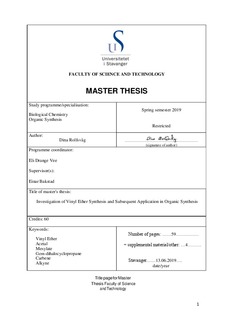| dc.description.abstract | The standard method of synthesizing vinyl ethers from the elimination of an alcohol from an acetal was tested against synthesizing them through the elimination of a mesyloxy group. A total of seven different molecules were tested in both methods. For the first method only three of the vinyl ethers survived the technique, the rest polymerized. The second method worked with fair to good yields on all the molecules. The key synthetic strategies in the secondary method was the Corey-Chaykovsky reaction or the Prilezhaev reaction for epoxidation, regioselective ring opening with Lewis acid, a functional group interconversion, and an elimination.
Making acetylenes from vinyl ethers through a gem-dihalocyclopropane intermediate is a relatively unexplored pathway. Two members of the Bakstad research group, D. Maharjan and Y. Luijkx, have already investigated the synthesis of acetylenes using this pathway. In this thesis, only two vinyl ethers were additionally explored, and the reactions worked with fair yields giving the desired product. This carbene reaction could have great potential in synthesizing new molecules and aid in pharmaceutical production.
Robert H. Grubbs won the Nobel prize in 2005 in chemistry on his work on a metathesis catalyst.[1] He found that metathesis on vinyl ethers lead to polymerization and thereby synthesized a ruthenium carbene complex catalyst that bypassed this issue. It is also of incredibly high interest that he introduced a strong -donating NHC to obtain a second catalyst with higher activity. His work and the acknowledgement he got for it summarizes the importance of vinyl ethers, avoiding polymerization and the interesting effects of carbenes. All of which are essential points in this thesis.
From the work in this thesis 17 novel molecules have been synthesized. According to the authors best knowledge compounds 8, 10, 11, 15, 38, 39, 40, 45, 46, 47, 48, 49, 51, 52, 54, 55 and 56 have not been prepared before. The novel vinyl ethers synthesized are depicted in Figure 1.
Figure 1. Novel Vinyl Ethers synthesized. | nb_NO |

